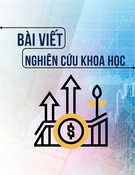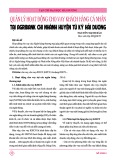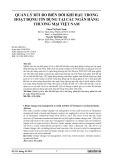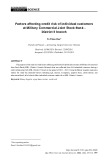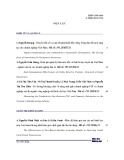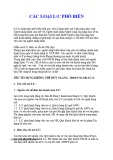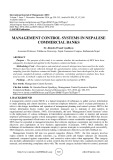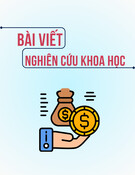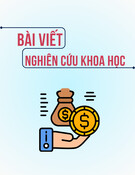
CHAPTER 32
Credit Management
Answers to Practice Questions
1. a. There is a 2% discount if the bill is paid within 30 days of the invoice date;
otherwise, the full amount is due within 60 days.
b. The full amount is due within 10 days of invoice.
c. There is a 2% discount if payment is made within 5 days of the end of the
month; otherwise, the full amount is due within 30 days of the invoice date.
2. a. Paying in 60 days (as opposed to 30) is like paying interest of $2 on a $98
loan for 30 days. Therefore, the equivalent annual rate of interest, with
compounding, is:
27.86%.278601
98
100 30)/(365
==−
b. No discount.
c. For a purchase made at the end of the month, these terms allow the buyer
to take the discount for payments made within five days, or to pay the full
amount within thirty days. For these purchases, the interest rate is
computed as follows:
34.31%.343101
98
100 25)/(365
==−
For a purchase made at the beginning of the month, these terms allow the
buyer to take the discount for payments made within thirty-five days, or to
pay the full amount within thirty days of the purchase. Clearly, under
these circumstances, the buyer will take the discount and pay within thirty-
five days. The interest rate is negative.
3. When the company sells its goods cash on delivery, for each $100 of sales, costs
are $95 and profit is $5. Assume now that customers take the cash discount
offered under the new terms. Sales will increase to $104, but after rebating the
cash discount, the firm receives: (0.98 × $104) = $101.92
Since customers pay with a ten-day delay, the present value of these sales is:
$101.757
1.06
$101.92
(10/365) =
Since costs remain unchanged at $95, profit becomes:
$101.757 - $95 = $6.757
50

If customers pay on day 30 and sales increase to $104, then the present value of
these sales is:
$103.503
1.06
$104
(30/365) =
Profit becomes: ($103.503 - $ 95) = $8.503
In either case, granting credit increases profits.
4. The more stringent policy should be adopted because profit will increase. For every
$100 of current sales:
Current Policy
More Stringent Policy
Sales
$100.0
$95.0
Less: Bad Debts*
6.0
3.8
Less: Cost of Goods**
80.0
76.0
Profit
$14.0
$15.2
* 6% of sales under current policy; 4% under proposed policy
** 80% of sales
5. Consider the NPV (per $100 of sales) for selling to each of the four groups:
Classification NPV per $100 Sales
1
2
3
4
If customers can be classified without cost, then Velcro should sell only to
Groups 1, 2 and 3. The exception would be if non-defaulting Group 4 accounts
subsequently became regular and reliable customers (i.e., members of Group 1,
2 or 3). In that case, extending credit to new Group 4 customers might be
profitable, depending on the probability of repeat business.
51
$13.29
1.15
0)(1100
85 365/45 =
−×
+−
$11.44
1.15
.02)0(1100
85 365/42 =
−×
+−
3.63$
1.15
.10)0(1100
85 365/40 =
−×
+−
7.41$
1.15
0.20)(1100
85 365/80 −=
−×
+−

6. By making a credit check, Velcro Saddles avoids a $7.41 loss per $100 sale
25 percent of the time. Thus, the expected benefit (loss avoided) from a credit
check is:
0.25 × 7.41 = $1.85 per $100 of sales, or 1.85%
A credit check is not justified if the value of the sale is less than x, where:
0.0185 x = 95
x = $5,135
7. Original terms:
$17.70
1.12
100
80sales$100perNPV 365/75 =+−=
Changed terms: Assume the average purchase is at mid-month and that the
months have 30 days.
$17.27
1.12
100)(0.40
1.12
98)(0.60
80 sales$100perNPV 365/80365/30 =
×
+
×
+−=
8. For every $100 of prior sales, the firm now has sales of $102. Thus, the cost of
goods sold increases by 2%, as do sales, both cash discount and net:
9. Some of the most important ratios to consider are:
(1) Measures of leverage: debt ratio, times-interest-earned
(2) Measures of liquidity: cash ratio, quick ratio
(3) Measures of profitability: return on assets
(4) Measures of efficiency: especially important is the average
collection period.
(5) Market-value ratios: such as the market-to-book ratio
Identifying the least informative ratios depends on the circumstances. However,
some points to note in this regard are:
(1) Efficiency ratios are often difficult to interpret.
(2) Liquidity ratios may be misleading in some circumstances, for
example, if a company has an unused line of credit.
(3) A high price-earning ratio might be the result of temporarily low
earnings.
52
$17.6217.271.02salesinitialof$100perNPV =×=

10.Some common problems are:
a. Dishonest responses (usually not a significant problem).
b. The company never learns what would have happened to rejected
applicants, nor can it revise the coefficients to allow for changing customer
behavior.
c. The credit scoring system can only be used to separate (fairly obvious)
sheep from goats.
d. Mechanical application may lead to social and legal problems (e.g.,
red-lining)
e. The coefficient estimation data are, of necessity, from a sample of actual
loans; in other words, the estimation process ignores data from loan
applications that have been rejected. This can lead to biases in the credit
scoring system.
f. If a company overestimates the accuracy of the credit scoring system, it
will reject too many applicants. It might do better to ignore credit scores
altogether and offer credit to everyone.
11. In real life:
a. Repeat orders are not certain, even if the customer pays for the first one.
b. Customers might make partial or delayed payments.
c. There are more than two periods.
d. Order size is not constant.
e. The probabilities of payment are unknown.
The complexity of these factors means that experience and judgement are
necessary in the management of credit; scientific models, while helpful, cannot
do the entire job.
12.a. Other things equal, it makes more sense to grant credit when the profit margin is
high. The expected profit from offering credit (where p is the probability of
payment) is:
[p × PV(REV – COST)] – [( 1 – p) × PV(COST)]
Rearranging, expected profit is:
PV(REV – COST) – [( 1 – p) × PV(REV)]
If the difference between revenue and cost is small, then extending credit
is more likely to result in a loss. Suppose that, for example, the profit
margin is 10% so that PV(REV) = $100 and PV(COST) = $90, and the
probability of payment is p = 90% (so that the probability of default is
10%). Then the firm breaks even: [$100 - $90 – (0.10 × $100)] = $0
If the profit margin is only 5% and the probability of default remains at
10%, the result is a loss: [$100 - $95 – (0.10 × $100)] = -$5
53

b. Other things equal, it is more costly to grant credit when interest rates are
high. Since the effect of granting credit is to postpone receipt of revenues,
the present value of revenues is reduced by high interest rates. Suppose
that, for example, the only effect of granting credit is to postpone payment
by 30 days. If the interest rate is 10%, this reduces PV(REV) by:
1.10(30/365) – 1 = 0.0079 = 0.79%
If the rate is 5%, then PV(REV) is reduced by:
1.05(30/365) – 1 = 0.0040 = 0.40%
c. If the probability of repeat orders is high, you should be more willing to
grant credit because, if the customer pays promptly, you may then have a
regular customer who is less likely to default in the future. (Page 917 of
the text provides a numerical example.)
13.Internet exercise; answers will vary.
14.Internet exercise; answers will vary.
54

